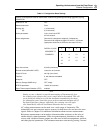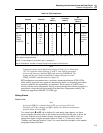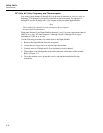
Operating the Instrument from the Front Panel
Channel Configuration
3
3-13
be changed at any point is brightly lit (solid for digits, flashing for other annunciators);
all other elements are dimly lit at this time. Table 3-9 presents a full description of the
Mx+B configuration sequence.
If you press C while setting the "M" value (anytime prior to showing the "B" value),
no changes entered thus far are stored. If you press C while setting the "B" value,
changes to M are stored and changes to "B" are discarded. In either case, the instrument
returns to Inactive Mode.
The final E press shown in Table 3-9 stores all changes and returns the instrument to
Inactive Mode.
Note
Once Mx+B scaling values are defined for a channel, the instrument uses
the range chosen for the B value as the display range for the resulting
scaled value. If the result is larger than the display range chosen, an
overload ("OL") is displayed.
For example, you could monitor the output of a high-pressure pump by using Mx+B
scaling to convert the millivolt output of a pressure transducer to PSI. Such a transducer
might output 0 to 30 mV, corresponding to pressure of 0 to 5000 PSI. The scaling values
to convert the transducer millivolts to PSI would be M = 166.67 PSI/V and B = 0 PSI,
calculated as follows:
Max Display Value Min Display Value 5000
M = = = 166.67
Max Transducer Output Min Transducer Output 30
B = Min Display Value - (M * Min Transducer Output) = 0 - 166.67 * 0 = 0
When a channel that has had scaling values entered is scanned or monitored, the
resulting scaled value is displayed without the underlying function annunciation. The
decimal point location and scale factor for the result is fixed by the "B" value entered. If
the scaled value is too small to be represented in 5 digits given this scaling, zero is
displayed. If the scaled value is too large, "OL" (overload) is displayed (even if the
underlying measurement was on scale.) "OL" is also displayed if the measurement is in
overload.
If scanning or monitoring a scaled channel gives unexpected results (like zero or
overload), make the following checks:
1. Verify that the values and scale factors of "M" and "B" are set as intended.
2. Verify that the desired values are the correct values: calculate the result for a few
measured values using the entered "M" and "B".
3. Temporarily set "M" to 1 and "B" to 0; verify that the measurements are returning
values in the expected range. Unexpected measurements could result from a wiring
error or the wrong range/function being selected.


















